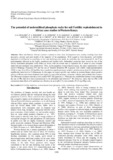The potential of underutilized phosphate rocks for soil Fertility replenishment in Africa:case studies in Western Kenya

View/
Date
2007Author
Okalebo, JR
Woomer, PL
Othieno, CO
Karanja, NK
Ikerra, S
Esilaba, AO
Nekesa, AO
Ruto, EC
Thuita, MN
Ndungu, KW
Kifuko, MN
Bationo, A
Language
enMetadata
Show full item recordAbstract
Most sub-Saharan African countries continue to have slow development rates, mainly resulting from food
insecurity, poverty and poor health of the majority of the populations. With regard to food insecurity, soil fertility
depletion is well-known to contribute to low and declining crop yields. In particular, the macronutrients N and P are
predominantly deficient in the highly weathered and leached soils. Substantial researches have tested the use of the
widely distributed phosphate rocks (PRs) in Africa with an overall aim to replenish the P status of soils, towards
improved and sustained crop productivity. Thus, in the populous western Kenya region, the direct applications of the
reactive Minjingu (Tanzania) PR and the use of blended Busumbu PR (Uganda) with soluble triplesuperphosphate
(TSP) at rates from 20 to 150 kg P/ha, have resulted in significant maize (staple) yield increases from 0.5 t/ha/season at
smallholder farm level to 5 t/ha/season. In this paper we report specific case studies in western Kenya where positive
effects of PR use have been obtained with respect to crop yield increases, economic viabilityand residual effectiveness.
The PR tested compares favorably with soluble TSP. The question is: “What ails the smallholder farmers fromadopting
the use of PRs that have been demonstrated to be affordable and effective?” We however, stress that the PRs (with
concurrent maineffectsofP and lime) are effective onacid (pH<5.5), lowavailable P (<5mgP/kg) soils.
Citation
African Crop Science Conference ProceedingsVol. 8. pp.1589-1598Publisher
African Crop Science Society & Minia University
